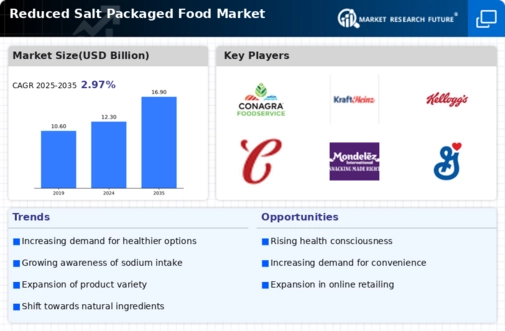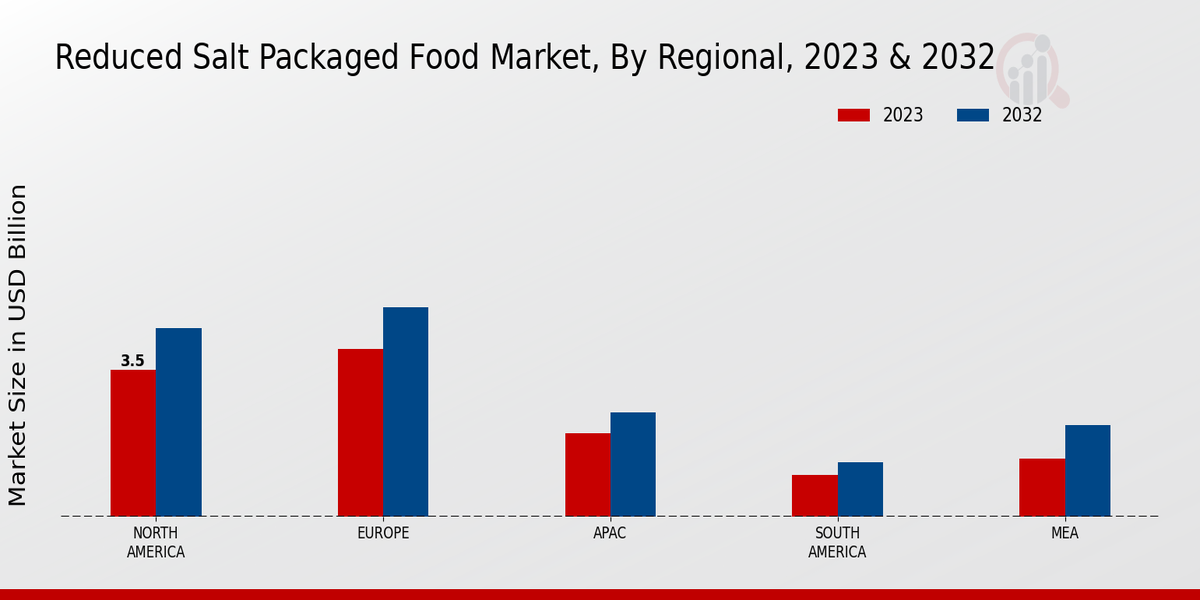Aging Population
The demographic shift towards an aging population is likely to drive the Global Reduced Salt Packaged Food Market Industry. Older adults often face health challenges that necessitate dietary modifications, including reduced sodium intake. This demographic trend suggests a growing market for products tailored to meet the specific needs of seniors. As the population aged 65 and older continues to rise, the demand for reduced salt packaged foods may increase, contributing to the market's projected CAGR of 2.95% from 2025 to 2035. This demographic factor underscores the importance of catering to health-conscious older consumers.
Regulatory Support
Government regulations promoting reduced sodium consumption significantly influence the Global Reduced Salt Packaged Food Market Industry. Various health organizations advocate for lower salt intake, leading to policies that encourage food manufacturers to reformulate their products. This regulatory landscape not only fosters innovation but also enhances consumer trust in reduced salt offerings. As a result, the market is expected to expand, with projections indicating a value of 16.9 USD Billion by 2035. Such supportive measures may catalyze the development of new products, ensuring that consumers have access to healthier alternatives.
Health Consciousness
The rising awareness regarding health and wellness among consumers appears to be a primary driver for the Global Reduced Salt Packaged Food Market Industry. As individuals increasingly prioritize healthier dietary choices, the demand for reduced salt options is likely to surge. This trend is reflected in the projected market value of 12.3 USD Billion in 2024, indicating a robust consumer shift towards products that promote better health outcomes. Furthermore, the emphasis on reducing sodium intake aligns with global health initiatives aimed at combating hypertension and cardiovascular diseases, thereby reinforcing the market's growth trajectory.
Market Growth Projections
The Global Reduced Salt Packaged Food Market Industry is projected to experience steady growth, with estimates indicating a market value of 12.3 USD Billion in 2024 and a potential increase to 16.9 USD Billion by 2035. This growth trajectory, characterized by a CAGR of 2.95% from 2025 to 2035, suggests a sustained demand for reduced salt options as consumers become increasingly health-conscious. The market dynamics reflect a broader trend towards healthier eating habits, driven by both consumer preferences and regulatory influences.
Innovation in Food Technology
Advancements in food technology are playing a crucial role in shaping the Global Reduced Salt Packaged Food Market Industry. Innovative techniques for flavor enhancement without the need for excessive sodium are emerging, allowing manufacturers to create appealing products that meet consumer preferences. This technological evolution not only addresses taste concerns but also aligns with health trends, making reduced salt options more attractive. As a result, the market is poised for growth, with a projected increase in value to 16.9 USD Billion by 2035, reflecting the potential of innovation to drive consumer acceptance.
Increased Availability of Products
The growing availability of reduced salt packaged foods in retail outlets is a significant driver for the Global Reduced Salt Packaged Food Market Industry. As supermarkets and grocery stores expand their health food sections, consumers are more likely to encounter a variety of reduced salt options. This increased accessibility may encourage trial and adoption among health-conscious shoppers. With the market expected to reach 12.3 USD Billion in 2024, the proliferation of these products in mainstream retail channels is likely to enhance consumer awareness and acceptance, further propelling market growth.






















